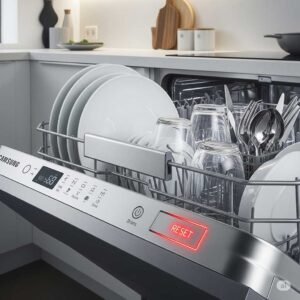Is your Samsung dishwasher acting up? Don’t rush to call a technician just yet! Often, a simple reset is all it takes to clear glitches and restore your appliance’s normal function. This guide will show you exactly how to reset your Samsung dishwasher effectively, covering various scenarios and providing solutions to get you back to sparkling dishes.
Table of Contents
Why Your Samsung Dishwasher Need A Reset ?
Think of your dishwasher like a computer. Sometimes, software glitches, power fluctuations, or even minor sensor issues can cause it to behave erratically. A reset acts like a reboot, clearing temporary errors and allowing the system to restart fresh. You might need to reset your dishwasher if you experience:
- Unresponsive control panel: Buttons aren’t working, or the display is frozen.
- Error codes: Mysterious numbers or letters appear on the display, signaling a problem.
- Cycles not starting or completing: Your dishwasher isn’t running as it should.
- Unexpected pauses: The wash cycle stops mid-way without apparent reason.
- Minor performance issues: Dishes aren’t as clean as they should be, or the drying cycle isn’t effective.

Methods for Resetting Your Samsung Dishwasher
There are several ways to reset your device, ranging from a quick soft reset to a more involved hard reset. We’ll cover each method, so you can choose the best one for your situation.
1. The Simple Power Cycle (Soft Reset)
This is the easiest and most common way to reset your machine. It’s often the first step in troubleshooting any appliance issue.
How to do it:
- Turn off the dishwasher: Press the Power button on your dishwasher’s control panel.
- Unplug the dishwasher: Locate the power cord and carefully unplug it from the electrical outlet. If your dishwasher is hardwired, you’ll need to trip the circuit breaker for the dishwasher at your home’s electrical panel.
- Wait 1-5 minutes: This crucial step allows any residual electrical charge to dissipate from the system, effectively clearing its memory.
- Plug it back in or restore power: Reconnect the power cord or flip the circuit breaker back on.
- Turn on the dishwasher: Press the Power button again.
When to use it: This method is effective for minor glitches, unresponsive controls, or when a cycle unexpectedly stops.
2. Resetting via the Control Panel
Some Samsung dishwasher models have specific button combinations that can trigger a reset. This method is often used to clear specific error codes or to reset a stuck program.
How to do it:
- Hold down the Start/Reset button: Many Samsung models have a dedicated Start/Reset or Cancel & Drain button. Press and hold this button for 3-5 seconds. You might hear a beep, and the display lights may flash, indicating a reset.
- Specific Button Combinations: For some models, you might need to press and hold a combination of buttons, such as Power and Start, or Smart Auto and Heavy, for a few seconds. Refer to your dishwasher’s user manual for model-specific instructions.
When to use it: This is useful when the control panel is responsive but you’re trying to clear an error code or cancel a cycle.
3. Circuit Breaker Reset (Hard Reset)
This method is similar to unplugging but is necessary for hardwired dishwashers or when the power cycle via unplugging doesn’t resolve the issue. It provides a complete power cut to the appliance.
How to do it:
- Locate your home’s electrical panel: This is usually in your basement, garage, or a utility closet.
- Identify the circuit breaker for your dishwasher: It should be labeled. If not, you might need to switch off breakers one by one until the dishwasher loses power.
- Flip the breaker to the “Off” position: Ensure it’s completely off.
- Wait for 5-10 minutes: Again, this allows the system to fully discharge.
- Flip the breaker back to the “On” position:
- Turn on your dishwasher: Test if the issue is resolved.
When to use it: Use this for persistent error codes, a completely unresponsive dishwasher, or when the softer reset methods fail.
What Error Codes Say in Samsung Dishwasher
Sometimes, your Samsung dishwasher displays an error code instead of simply misbehaving. These codes are designed to give you a hint about what’s wrong. While a reset can sometimes clear these codes, understanding them can help you determine if a more significant issue is at play.
Here’s a table of some common Samsung dishwasher error codes and what they often indicate:
Error Code | Potential Issue | What to Check |
LE | Water Leakage | Check for visible leaks under the dishwasher. Ensure the dishwasher is level. Inspect the water inlet hose and drain hose for damage or loose connections. A reset might clear a false alarm, but a persistent LE code usually indicates a real leak. |
OE | Overflow Error | This indicates too much water in the tub. Check the drain hose for kinks or clogs. Ensure the air gap (if installed) is clear. The drain pump might be faulty. |
HE / HE1 | Heating Error / Overheating | The water isn’t heating properly, or the heater is overheating. This could be a faulty heating element, temperature sensor, or main control board. |
4E / 4C | Water Supply Issue | The dishwasher isn’t getting enough water. Check if the water supply valve is fully open. Inspect the water inlet hose for kinks or clogs. Ensure water pressure is adequate. The water inlet valve might be defective. |
5E / 5C | Drainage Error | Water isn’t draining correctly. Check the drain hose for kinks, clogs, or blockages. Clean the filter at the bottom of the dishwasher. Ensure the garbage disposal (if connected) is clear. The drain pump might be faulty. |
bE2 / 3E | Button Stuck / Communication Error | A button on the control panel might be stuck or there’s a communication issue. Try pressing each button to ensure none are jammed. A soft reset often resolves this. |
oC / OC | Over-level Water | Similar to OE, this means too much water. Check for blockages in the drain system or a faulty water level sensor. |
PE | Pressure Sensor Error | Indicates a problem with the pressure sensor, which monitors water levels. This could be due to a clog or a faulty sensor. |
dF | Door Latch Error | The door is not properly closed or latched. Ensure the door is securely shut. Check if anything is obstructing the latch. The door latch mechanism or sensor might be faulty. |
tE | Temperature Sensor Error | Problem with the temperature sensor. This can affect heating and drying. |
lo / LC | Child Lock / Control Lock (often accompanied by a lock icon) | This indicates the control panel is locked. To unlock, usually press and hold the Child Lock or Control Lock button (or combination of buttons as per your manual) for 3-5 seconds until the lock icon disappears. |
oH / F | Overheating / Malfunction | Indicates the dishwasher has overheated or a general malfunction. A reset might help, but persistent errors suggest a component failure. |
Important Note: Always consult your specific Samsung dishwasher model’s user manual for the most accurate and detailed information on error codes and troubleshooting.
When a Reset Isn’t Enough: Next Steps
While a reset is a powerful tool, it won’t fix every problem. If you’ve tried the various reset methods and your dishwasher is still acting up, consider these next steps:
- Check the basics:
- Is the water supply on? Ensure the water valve connected to your dishwasher is fully open.
- Is the door fully latched? Most dishwashers won’t start if the door isn’t securely closed.
- Are the spray arms blocked? Make sure no dishes or utensils are preventing the spray arms from rotating freely.
- Are the filters clean? Clogged filters can significantly impact washing and draining performance. Refer to your manual for how to clean them.
- Inspect the drain hose: Look for kinks, twists, or blockages in the drain hose. If your dishwasher drains into a garbage disposal, ensure the disposal is clear and not blocked.
- Review your user manual: Your Samsung dishwasher’s user manual is an invaluable resource. It contains model-specific troubleshooting tips, detailed explanations of error codes, and instructions for specific functions. If you don’t have a physical copy, you can usually find a PDF version by searching online with your dishwasher’s model number.
- Check for recalls: Although rare, sometimes appliance issues stem from a known manufacturing defect. Check the Consumer Product Safety Commission (CPSC) website or Samsung’s official website for any active recalls related to your dishwasher model.
- Contact Samsung Support: If you’ve exhausted all troubleshooting steps and your dishwasher is still not functioning correctly, it’s time to contact Samsung customer support or schedule a service appointment with a qualified technician. Provide them with your dishwasher’s model number and a detailed description of the issue, including any error codes you’ve observed.
How to Prevent Future Issues
While you can’t prevent every appliance problem, proper maintenance can significantly reduce the likelihood of needing to reset your dishwasher frequently.
- Regularly clean filters: Food debris and grease can clog filters, leading to drainage issues and poor washing performance.
- Run a monthly cleaning cycle: Use a dishwasher cleaner or a cup of white vinegar on an empty cycle to remove mineral buildup and odors.
- Scrape plates before loading: While not necessary to pre-rinse, scraping off large food particles prevents them from clogging the drain.
- Load correctly: Don’t overload the dishwasher, and ensure items aren’t blocking spray arms or the detergent dispenser.
- Check water temperature: Ensure your hot water heater is set to an adequate temperature (around 120°F / 49°C) for effective cleaning.
- Inspect hoses periodically: Look for any signs of wear, kinks, or leaks in the water inlet and drain hoses.
By following these simple maintenance tips, you can extend the life of your Samsung dishwasher and keep it running smoothly.
FAQ
You should wait at least 1 to 5 minutes after unplugging your Samsung dishwasher (or flipping the circuit breaker) before restoring power. This allows the internal components to fully discharge and the system’s memory to clear effectively.
A soft reset (power cycle) typically will not erase your customized settings like delay start or specific wash options. However, a factory reset (if available on your model and intentionally performed) would restore all settings to their default factory configuration. Most common resets only clear temporary glitches.
If your control panel is completely unresponsive, the first step is to perform a power cycle (soft reset). Unplug the dishwasher for 5 minutes or turn off its dedicated circuit breaker. If the panel remains unresponsive after restoring power, there might be a more significant electrical issue or a faulty control board, requiring professional service.
If an error code persists after multiple resets, it indicates that the underlying issue has not been resolved. A reset can clear temporary glitches, but it cannot fix a physical problem like a clogged drain, a faulty sensor, or a broken component. You’ll need to troubleshoot the specific error code as outlined in your user manual or contact Samsung support.
Most Samsung dishwashers do not have a single “factory reset” button. A true factory reset usually involves a more complex procedure, if available at all, and is typically reserved for service technicians. The common resets mentioned in this guide are for clearing temporary errors, not for restoring factory defaults. Always refer to your specific model’s manual for any mention of a factory reset.
Yes, you can often cancel a cycle by pressing and holding the “Start/Reset” or “Cancel & Drain” button for a few seconds. This will usually drain the water and stop the current cycle, effectively performing a soft reset of the running program. You can then power cycle the machine if further resetting is needed.
If your dishwasher displays “lo” or a lock icon, it means the Child Lock or Control Lock is active. To reset or disable it, you typically need to press and hold the designated “Child Lock” or “Control Lock” button (or a specific button combination indicated in your manual) for 3-5 seconds until the lock indicator disappears. A general reset won’t typically disable this feature; it must be manually unlocked.
Bottom Line
Knowing how to reset your Samsung dishwasher is a valuable skill that can save you time and potential repair costs. By understanding the different reset methods and what each error code signifies, you can effectively troubleshoot many common issues yourself. Remember, regular maintenance is key to keeping your appliance running smoothly.



